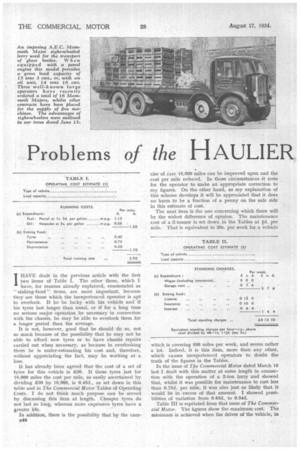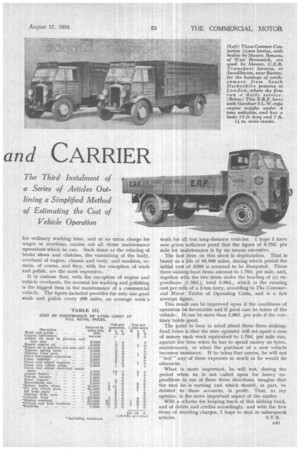Problems of the HAULIER and CARRIER I HAVE dealt in the
Page 58

Page 59

If you've noticed an error in this article please click here to report it so we can fix it.
previous article with the first two items of Table I. The other three, which I have, for reasons already explained, enumerated as " sinking-fund" items, are more important, because they are those which the inexperienced operator is apt to overlook. If he be lucky with his vehicle and if his tyres last longer than usual, or if for a long time no serious major operation be necessary' in connection with the chassis, he may be able to overlook them for a longer period than the average.
It is not, however, good that he should do so, not so much because of the possibility that he may not be able to afford new tyres or to have chassis repairs carried out when necessary, as because in overlooking them he is under-estimating his cost and, therefore, without appreciating the fact, may be working at a loss.
It has already been agreed that the cost of a set of tyres for this vehicle is £30. If those tyres .last for 16,000 miles the cost per mile, as easily ascertained by dividing £30 by 16,000, is 0.45d., as set down in this table and in The Commercial Motor Tables of Operating Costs. I do not think much purpose can be served by discussing this item at length. Cheaper tyres do not last so long, whereas more expensive tyres have a greater life.
In addition, there is the possibility that by the exerB44 cise of care 16,000 miles can be improved upon and the cost per mile reduced. In those circumstances it rests for the operator to make an appropriate correction to ,my figures. On the other hand, as my explanation of this scheme develops it will be appreciated that it does no harm to be a fraction of a penny on the safe side in this estimate of cost.
The next item is the one concerning which there will be the widest difference of opinion. The maintenance cost of a .2-tormer is set down in the Tables at id. per, mile. That is equivalent to 30s. per week for a vehicle which is covering 500 miles per week, and seems rather a lot. Indeed, it is this item, more than any other, which causes inexperienced operators to doubt the truth of the figures in the Tables.
In the issue of The Commercial Motor dated March 16 last I dealt with this matter at some length in connection with the operation of a 2-ton lorry and showed that, whilst it was possible for maintenance to cost less than 0.75d. per mile, it was also just as likely that it would he in excess of that amount. I showed possibilities of variation from 0.63d. to 0.94d.
Table HI is reprinted from that issue of The Commercial Motor. The figures show the maximum cost. The minimum is achieved when the driver of the vehicle, iii
his ordinary working time, and at no extra charge for wages or overtime, carries out all those maintenance operations which he can. Such items as the refacing of brake 'shoes and clutches, the varnishing of the body, overhaul of engine, chassis and body, and sundries, remain, of course, and they, with the exception of wash and polish, are the most expensive.
It is curious that, with the exception of engine and vehicle overhauls, the account for washing and polishing is the biggest item in the maintenance of a commercial vehicle. The figure included provides for only one good wash and polish every 400 miles, an average week's
work for all but long-distance vehicles. I hope I have now given sufficient proof that the figure of 0.75d. per mile for maintenance is by no means excessive.
The last item on this sheet is depreciation. That is based on a life of 96,000 miles, during which period the initial cost of 200 is assumed to be dissipated. These three sinking-fund items amount to 1.70d. per mile, and, together with the two items under the heading of (a) expenditure (1.20d.), total 2.90d., which is the running cost per mile of a 2-ton lorry, according to The Commercial Motor Tables of Operating Costs, and is a fair average figure.
This result can be improved upon if the conditions of operation be favourable and if good care be taken of the vehicle. It can be more than 2.90d. per mile if the contrary holds good.
The point to bear in mind about these three sinkingfund items is that the wise operator will set apart a sum of money each week equivalent to 1.70d. per mile run, against the time when he has to spend money on tyres, maintenance, or when the purchase of a new vehicle becomes imminent. If he takes that course, he will not " feel" any of these expenses so much as he would do otherwise.
What is more important, he will not, during the period when he is not called upon for heavy expenditure in one of these three directions, imagine that the sum: he is earning and which should, in part, be debited to these accounts, is profit. That, in my opinion, is the more important aspect of the matter.
With a scheme for keeping track of this sinking fund, and of debits and credits accordingly, and with the five items of standing charges, I hope to deal in subsequent articles. S.T.R.




























































































